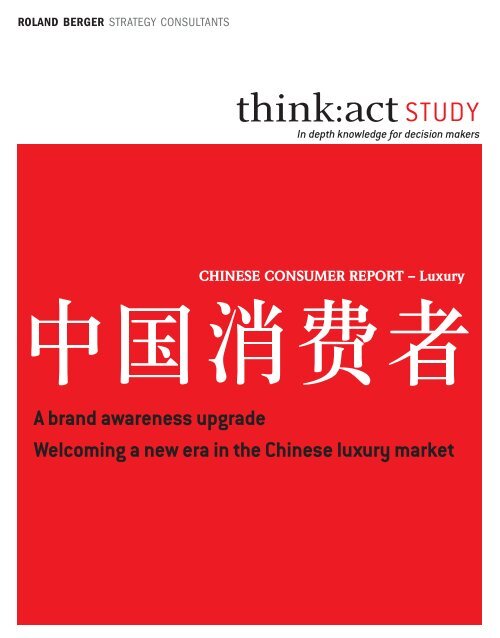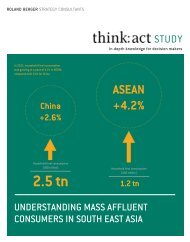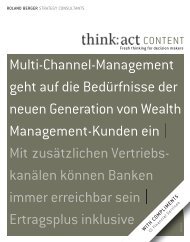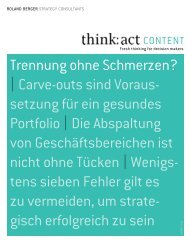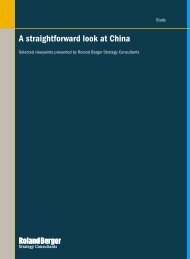Chinese Consumer Report 2012 - Luxury - Roland Berger
Chinese Consumer Report 2012 - Luxury - Roland Berger
Chinese Consumer Report 2012 - Luxury - Roland Berger
You also want an ePaper? Increase the reach of your titles
YUMPU automatically turns print PDFs into web optimized ePapers that Google loves.
ROLAND BERGER STRATEGY CONSULTANTS<br />
In depth knowledge for decision makers<br />
CHINESE CONSUMER REPORT – <strong>Luxury</strong><br />
A brand awareness upgrade<br />
Welcoming a new era in the <strong>Chinese</strong> luxury market
Foreword<br />
Defining <strong>Chinese</strong> luxury brand consumers<br />
Enhance brand awareness<br />
Winning in the luxury market<br />
2
Foreword<br />
China is close to becoming the second largest luxury market in the world and it is increasingly attracting the<br />
attention of major luxury brand producers worldwide. In view of this, <strong>Roland</strong> <strong>Berger</strong> conducted a study on the<br />
behavior of <strong>Chinese</strong> consumers when buying luxury goods and their choice of brands. The aim of the study was to<br />
offer those companies that wish to engage in this prestigious and lucrative market with valuable insights about their<br />
target consumers. To achieve this goal the study looks at the key factors influencing and determining the purchasing<br />
behavior of <strong>Chinese</strong> consumers: broadly their social characteristics as well as psychological and behavioral traits.<br />
Our experts further segmented the entire consumer population into six archetypes, which we call Era Leaders,<br />
Wealthy Second Generation, Ambitious Elites, Savvy Investors, Stylish White Collars and Gift Buyers.<br />
China has a great deal of consumers who can be characterized as Gift Buyers. In addition, "showing-off"<br />
(exhibitionism) is a significant feature in all the other archetypes too, albeit to varying degrees. One in four<br />
consumers in China belong to the archetype Era Leaders. One of their strong traits is a penchant to follow others.<br />
Given these findings it is not surprising that internationally famous brands are still the top choice for <strong>Chinese</strong> luxury<br />
goods consumers.<br />
To better understand the market, <strong>Roland</strong> <strong>Berger</strong> closely examined the considerations and actions that culminate<br />
in the purchase of luxury goods. They noticed that the purchase of a luxury good is the culmination of four distinct<br />
steps. We call these stages Origin of Consciousness, Selection of Brand/Product, On-site Decision and Final<br />
Purchase. Our experts further observed that brand awareness plays a very important role in each of the four stages.<br />
Member of Global Executive Committee<br />
President, Asia<br />
<strong>Roland</strong> <strong>Berger</strong> Strategy Consultants<br />
The increase in the number of consumers who can be characterized as Wealthy Second Generation, Ambitious Elites<br />
and Trendy White Collars suggests that <strong>Chinese</strong> consumers on a whole are maturing. These buyers – unlike most of<br />
their peers – do not choose certain brands for the sole purpose of "showing off". On the contrary, they are choosing<br />
brands that make them feel good, that give them a certain sense of self-satisfaction.<br />
There is a shifting preference toward unique luxury brands, which requires a more nuanced understanding of the<br />
luxury goods market. There must be an awareness of more than just the top luxury brands. Today to be successful in<br />
China it is often enough for companies simply to have a well-recognized brand. But increasingly brand competition<br />
will intensify, especially as a wider range of brands becomes accepted.<br />
There is increasing brand awareness among buyers of luxury goods in China. This is a trend that all brand producers<br />
have to address and try to exploit, both luxury goods makers trying to maintain their leading position in the <strong>Chinese</strong><br />
luxury market and latecomers striving to quickly catch up to their more established counterparts.<br />
When it comes to brands, consumers are upgrading. And makers of luxury goods need to have a well-defined and<br />
focused strategy, particularly when investing resources. Accordingly, <strong>Roland</strong> <strong>Berger</strong> experts recommend that<br />
players thoroughly consider the following three aspects:<br />
1. Identify brand ambassadors—these are the "active information seekers". Marketing activities should target this<br />
group of consumers with the aim of having them "fall for the brand". They need to be aware of the brand and<br />
promote it within their social groups.<br />
2. Set up an interactive global store network. Given the fact that the <strong>Chinese</strong> are more likely to buy luxury goods<br />
abroad than they do at home, companies should differentiate in-store positioning both within China and abroad.<br />
Activities need to be undertaken to better manage how products are selected, customer service and how stores<br />
are assessed.<br />
3. Broaden the core market for marketing. Marketing and distribution activities should be extended beyond first-tier<br />
cities. Specifically for this exercise, we identified the key luxury market cities through our proprietary model based<br />
on spending power and economic scale. Store expansion should occur in these cities. Moreover these cities will<br />
form the main battlefield on which the war for brand awareness will be fought. These are the cities where brand<br />
preference and recognition will be built.<br />
3
Defining <strong>Chinese</strong> luxury brand consumers<br />
The capacity and increasing speed of the global luxury market<br />
[One billion euros]<br />
Other countries<br />
Other Asia-Pacific<br />
countries<br />
Japan<br />
<strong>Chinese</strong> mainland<br />
America<br />
Europe<br />
Who are <strong>Chinese</strong> luxury brand consumers?<br />
CAGR<br />
New market<br />
capacity<br />
New market<br />
proportion<br />
Source: <strong>Roland</strong> <strong>Berger</strong> Analysis<br />
Gender distribution Age distribution Household income distribution<br />
<strong>Chinese</strong> consumers are displaying a newfound<br />
and growing interest in luxury goods. The<br />
wealthy and elite are eagerly embracing the<br />
culture of the luxury market and wish to own<br />
the same brands that are popular in developed<br />
economies. This has not escaped the notice of<br />
mainstream luxury brand producers. In recent<br />
years they have seen their products become<br />
a feature of daily life in China to a moderate<br />
but steadily increasing degree. If luxury goods<br />
makers are to capitalize on this trend they<br />
should move quickly to acquire and develop<br />
a deeper understanding of <strong>Chinese</strong> luxury<br />
consumers. As <strong>Chinese</strong> luxury consumers are<br />
expected to account for 40% of the new luxury<br />
market globally between 2010- 2015, it is an<br />
opportunity that few can afford to miss.<br />
Male<br />
Female<br />
China<br />
Source: 2011 <strong>Roland</strong> <strong>Berger</strong>’s <strong>Chinese</strong> <strong>Luxury</strong> <strong>Consumer</strong>s Survey (n=1,393), Germany 2010 Survey; <strong>Roland</strong> <strong>Berger</strong> analysis<br />
Archetypes of <strong>Chinese</strong> luxury consumers<br />
Archetypes:<br />
Western<br />
European<br />
<strong>Consumer</strong>s<br />
Era leader<br />
Wealthy second<br />
generation<br />
Western<br />
European<br />
<strong>Consumer</strong>s<br />
China<br />
highest<br />
20%<br />
medium<br />
30%<br />
lowest<br />
50%<br />
Ambitious elites Savvy investors<br />
Western<br />
European<br />
<strong>Consumer</strong>s<br />
Stylish whitecollars<br />
China<br />
Gift buyers<br />
Buyers of luxury goods in China are younger<br />
than buyers in mature markets. This can<br />
be attributed to a large degree to China's<br />
demography. China has a relatively young<br />
age population and wealth creation has been<br />
mostly concentrated in the young generation<br />
since the country's social and economic<br />
reform. A further differentiating factor,<br />
however, is that <strong>Chinese</strong> luxury consumers are<br />
often found in the top social status group as<br />
opposed to the more general across-the-board<br />
distribution that occurs in mature markets.<br />
Archetypes<br />
% Share ~25% ~30% ~10% ~5% ~10% ~20%<br />
Social profile<br />
Psychological<br />
traits<br />
Behavioral<br />
traits<br />
> private business<br />
owners, corporate<br />
executives<br />
(foreign, stateowned,<br />
private)<br />
> 25 to 40 years<br />
old<br />
Pursue<br />
>worship<br />
>wisdom<br />
>self-cultivation<br />
>follow others<br />
> recognize top<br />
brands<br />
> young people<br />
from the second<br />
generation of<br />
the wealthy<br />
and officials,<br />
including “rich<br />
men’s wives”<br />
> 20 to 35 years<br />
old<br />
Pursue<br />
>innovation<br />
>self-confidence<br />
>passion<br />
> are independent<br />
> have strong selfawareness<br />
> middle managers<br />
of multinational<br />
or state-owned<br />
companies,<br />
professionals,<br />
entrepreneurs<br />
> 25 to 35 years<br />
old<br />
Pursue<br />
>enterprise<br />
>passion<br />
>challenge<br />
> have strong selfawareness<br />
> have a good<br />
understanding of<br />
luxury goods<br />
> real estate<br />
speculators,<br />
stock traders,<br />
freelancers, the<br />
unemployed<br />
> 25 to 40 years<br />
old<br />
Pursue<br />
>trendiness<br />
>individuality<br />
>luxury<br />
> have fluctuating<br />
consumption<br />
capacity<br />
> focus on<br />
popularity<br />
> fresh to the<br />
workforce, have<br />
stable income<br />
higher than their<br />
peers<br />
> 20 to 30 years<br />
old<br />
Pursue<br />
>beauty<br />
>luxury<br />
>fashion<br />
> have strong selfawareness<br />
> have a good<br />
understanding of<br />
luxury goods<br />
> lack of distinctive<br />
features<br />
Pursue<br />
>worship<br />
>respect<br />
> have a low<br />
purchasing<br />
frequency<br />
> focus on<br />
popularity<br />
<strong>Roland</strong> <strong>Berger</strong> experts segmented <strong>Chinese</strong><br />
luxury consumers into six archetypes<br />
based on their physical, psychological and<br />
behavioral characteristics. The six archetypes<br />
are Era Leaders, Wealthy Second Generation,<br />
Ambitious Elites, Savvy Investors, Stylish<br />
White Collars and Gift Buyers. An in-depth<br />
appreciation of the uniqueness of these six<br />
groups can assist producers of luxury brands<br />
to devise more precise brand development<br />
strategies for the <strong>Chinese</strong> market.<br />
Source: 2011 <strong>Roland</strong> <strong>Berger</strong>’s <strong>Chinese</strong> <strong>Luxury</strong> <strong>Consumer</strong>s Survey (n=1,393), industry interviews; <strong>Roland</strong> <strong>Berger</strong> analysis<br />
4
Enhance brand awareness<br />
An analysis of the six archetypes shows that<br />
luxury goods makers presently focus their<br />
marketing on brand awareness. This arises<br />
not only because there is a large number<br />
of Gift Buyers in the <strong>Chinese</strong> market but,<br />
more importantly, because there is a lack of<br />
understanding of luxury goods among buyers.<br />
<strong>Consumer</strong>s in the groups Era Leaders and Savvy<br />
Investors are not yet confident when making<br />
purchasing decisions. When buying luxury<br />
goods these archetypes do not venture away<br />
from the top names. They buy top brands only.<br />
Analysis of <strong>Chinese</strong> luxury consumers purchasing behavior<br />
Origin of<br />
consciousness<br />
Selection<br />
factors<br />
Observation<br />
> reliance on social networks to get brand/product<br />
information<br />
> only well established brands with deep market<br />
penetration command the strong brand awareness of<br />
consumers<br />
> product selection usually made prior to visiting the<br />
channels<br />
>risk aversion and trying new brands<br />
>limited brand selection<br />
Implication<br />
> invest in<br />
resources to<br />
increase brand<br />
awareness<br />
> invest in<br />
resources to<br />
increase brand<br />
awareness<br />
To determine just how important brand<br />
awareness is for the luxury goods segment,<br />
<strong>Roland</strong> <strong>Berger</strong> experts looked very closely at<br />
the luxury goods purchasing process and saw<br />
that it could be divided into four steps. Brand<br />
awareness was significant at each of the four<br />
steps - origin of consciousness, selection<br />
factors, on-site decision and final purchase.<br />
Origin of consciousness, selection<br />
factors and obtaining information<br />
When buying luxury goods, <strong>Chinese</strong><br />
consumers are heavily reliant on the<br />
recommendations of others and from<br />
information gained at physical stores. As such,<br />
their purchasing decisions can be described<br />
as prudent, cautious and made without much<br />
credible information. Clearly, this is a huge<br />
obstacle for lesser-known luxury brands. Since<br />
<strong>Chinese</strong> consumers stick to the tried-and-true<br />
when buying high-end items, it makes it very<br />
difficult for lesser-known luxury brands to<br />
become known, recognized and alluring.<br />
Compared with consumers of other products,<br />
luxury goods consumers rely more heavily on<br />
social networks when obtaining information.<br />
This ties closely with the unique social aspect<br />
of luxury goods: they are a proof of social<br />
status.<br />
On-site<br />
decisions<br />
Final purchase<br />
> effect of brand awareness continues: brand popularity is<br />
more important than design/style<br />
> proliferation of brands, but the market is relatively<br />
concentrated<br />
> invest in<br />
resources to<br />
increase brand<br />
awareness<br />
> invest in<br />
resources to<br />
increase brand<br />
awareness<br />
Source: 2011 <strong>Roland</strong> <strong>Berger</strong>’s <strong>Chinese</strong> <strong>Luxury</strong> <strong>Consumer</strong>s Survey (n=1,393), industry interviews; <strong>Roland</strong> <strong>Berger</strong> analysis<br />
The main channels of getting information [%]<br />
Others’ recommendation<br />
Physical stores<br />
Magazines<br />
TV commercials<br />
Professional online<br />
channels of luxury goods<br />
Entertainment news<br />
Brand’s official website<br />
Posters/outdoor events<br />
User comment<br />
E-commerce websites<br />
Source: 2011 <strong>Roland</strong> <strong>Berger</strong>’s <strong>Chinese</strong> <strong>Luxury</strong> <strong>Consumer</strong>s Survey (n=1,393), Industry Interviews; <strong>Roland</strong> <strong>Berger</strong> Analysis<br />
5
Have you ever tried to buy some unfamiliar brands?<br />
Buy unfamiliar brands<br />
[mentioned %]<br />
Never<br />
1 out of 6 or 7<br />
1 out of 4 or 5<br />
1 out of 1 or 2<br />
Almost every time<br />
luxury goods<br />
clothing<br />
Channel predetermination<br />
[mentioned %]<br />
Q: Would you buy some unfamiliar brands?<br />
Q: Do you decide on the brand and product category<br />
before purchasing?<br />
Source: 2011 <strong>Roland</strong> <strong>Berger</strong>’s <strong>Chinese</strong> <strong>Luxury</strong> <strong>Consumer</strong>s Survey (n=1,393), accurate, <strong>Roland</strong> <strong>Berger</strong> Analysis<br />
On-site decision factors<br />
Determine<br />
brands and<br />
products<br />
Determine<br />
specific brand<br />
Determine<br />
specific product<br />
category<br />
On-site decision<br />
luxury clothing skin care mobile<br />
goods<br />
phone<br />
<strong>Chinese</strong> luxury consumers are not confident<br />
about the credibility of the information they<br />
receive. Cautious purchasing behavior is<br />
the result. They rarely buy unknown brands<br />
and do no buy on the spur of the moment.<br />
Purchases are made only after very thorough<br />
consideration.<br />
Similarly, consumers buying skin care<br />
products and mobile phones rarely make<br />
purchases on impulse or before lengthy<br />
consideration. For makers of luxury goods this<br />
is an important insight: the competitive battle<br />
begins at the earliest stage of the purchasing<br />
process.<br />
Reasons for buying the product<br />
[mentioned %]<br />
Reasons for not buying the product<br />
[mentioned %]<br />
On-site decisions<br />
Brand<br />
Design<br />
Quality<br />
Price<br />
luxury goods<br />
clothing<br />
Q: Which factor do you consider first when choosing<br />
the products?<br />
Don’t know the brand<br />
The brand culture/<br />
style doesn’t suit me<br />
The price is too high<br />
Others<br />
Source: 2011 <strong>Roland</strong> <strong>Berger</strong>’s <strong>Chinese</strong> <strong>Luxury</strong> <strong>Consumer</strong>s Survey (n=1,393), accurate, <strong>Roland</strong> <strong>Berger</strong> analysis<br />
Final purchase (taking high-end jewelry as an example)<br />
luxury goods<br />
Q: What kinds of brands won’t you buy?<br />
clothing<br />
Nothing is more important than brand for<br />
<strong>Chinese</strong> consumers when purchasing luxury<br />
goods in stores. Brand is more important than<br />
design, quality or price. When affordability<br />
is not an issue, <strong>Chinese</strong> consumers tend to<br />
upgrade to top-tier brands.<br />
Whereas it is common for consumers in more<br />
mature markets to reject a brand because it<br />
"doesn't suit them", this rarely occurs in China.<br />
Brands are rejected in China because they are<br />
not known.<br />
market share [%; 2010]<br />
Despite brand proliferation, the market is<br />
relatively concentrated due to the presence<br />
of certain more established brands. These<br />
established brands enjoy high brand<br />
awareness.<br />
Upgrading brand awareness<br />
operating history in China<br />
Source: 2011 <strong>Roland</strong> <strong>Berger</strong>’s <strong>Chinese</strong> <strong>Luxury</strong> <strong>Consumer</strong>s Survey (n=1,393), accurate, <strong>Roland</strong> <strong>Berger</strong> analysis<br />
brand awareness [%]<br />
<strong>Roland</strong> <strong>Berger</strong> believes that <strong>Chinese</strong> luxury<br />
goods consumers are becoming more<br />
sophisticated, evolving into buyers that<br />
purchase goods that make them feel good and<br />
give them a certain sense of self-satisfaction.<br />
6
These purchases are not made to show off. As<br />
buyers become more egoistic and rational we<br />
predict that brand preference and recognition<br />
will be increasingly important in the consumer<br />
decision-making process.<br />
In the future, the question of "whether a brand<br />
suits me" will become a more important<br />
factor for <strong>Chinese</strong> consumers when deciding<br />
to buy a luxury good. The rise of consumers<br />
that belong to the archetype groups Wealthy<br />
Second Generation, Ambitious Elites and Stylish<br />
White Collars will go hand-in-glove with more<br />
egoistic and independent purchasing decisions.<br />
Therefore, the battle of brand preference and<br />
recognition of luxury goods will ensure as the<br />
drive for increased brand awareness takes effect.<br />
The luxury car market provides a good<br />
example of how makers of luxury goods can<br />
position themselves in relation to the intrinsic<br />
qualities and associations that the brand<br />
wishes to project to <strong>Chinese</strong> luxury goods<br />
consumers. The brand positioning of the four<br />
luxury car brands are significantly different.<br />
The brand positioning has been made based<br />
on the uniqueness of the <strong>Chinese</strong> market<br />
within the larger framework of global brands.<br />
The four brands center around the values<br />
"distinguished", "beautiful", "exquisite",<br />
"credible", "advanced" and "dynamic". Each<br />
brand has a focus on this first level and further<br />
differentiates itself from its competitors on<br />
the second level. Take "distinguished" as an<br />
example: Whereas Mercedes Benz is linked to<br />
distinguished origin, BMW is linked to noble<br />
sports, and Lexus with implicit style. The<br />
pairings in the example of "beautiful" are also<br />
telling: Audi—fashion beauty, Benz—classic<br />
beauty, BMW— artistic beauty, and Lexus—<br />
purity and simplicity beauty.<br />
The evolution of the psychological demand of <strong>Chinese</strong> luxury consumers<br />
group affiliation<br />
(generally recognize)<br />
Source: <strong>Roland</strong> <strong>Berger</strong> analysis<br />
First level Second-level values MB BMW Audi Lexus<br />
Distinguished<br />
Beautiful<br />
Exquisite<br />
Credible<br />
Advanced<br />
Dynamic<br />
appreciation<br />
(products, service, existence)<br />
·compare with others<br />
· lacking taste and<br />
emotional demand<br />
show off<br />
(luxury, status)<br />
distinguished<br />
classic (eternal)<br />
Implicit<br />
tasteful (aesthetic, elegant)<br />
Attractive<br />
Simple (pure)<br />
exquisite (serious)<br />
caring<br />
high quality<br />
responsibility (credible)<br />
advanced technology<br />
(design model)<br />
Innovative<br />
Original<br />
Dynamic<br />
Young<br />
Athletic<br />
·egoistic<br />
·rational<br />
individuality<br />
(taste, culture)<br />
Commentary:<br />
Different brand positioning and translation of deluxe car brands<br />
In the past:<br />
·Characteristics of <strong>Chinese</strong> luxury market<br />
-- <strong>Consumer</strong>s had a relatively low level of<br />
education<br />
-- <strong>Consumer</strong>s valued brand awareness and<br />
popularity the most<br />
· Brand preference of <strong>Chinese</strong> luxury<br />
consumers<br />
--Social circle<br />
--Befitting status and occasion<br />
In the future:<br />
·Rational demand<br />
-- Satisfaction of rational needs, such as<br />
quality and comfort<br />
--Recognition of value for money<br />
·Emotional aspect<br />
--Focus on “whether the brand suits me”<br />
-- Pay more attention to personal taste,<br />
culture and modern values<br />
Pleasant<br />
Source: <strong>Roland</strong> <strong>Berger</strong> analysis<br />
7
Winning in the luxury market<br />
Comparison of consumers' level of involvement in the decision making process in<br />
different product groups<br />
Information seeking activity level<br />
[mentioned %]<br />
Often<br />
Sometimes<br />
Never<br />
luxury clothing skin care mobile<br />
goods<br />
phone<br />
Three characteristics of active information seekers<br />
luxury clothing skin care mobile<br />
goods<br />
phone<br />
Source: 2011 <strong>Roland</strong> <strong>Berger</strong>’s <strong>Chinese</strong> <strong>Luxury</strong> <strong>Consumer</strong>s Survey (n=1,393), Industry Interviews; <strong>Roland</strong> <strong>Berger</strong> Analysis<br />
Characteristics of active information seekers<br />
The number of brands<br />
recognized with/without<br />
prompting<br />
Often actively<br />
seek information<br />
Sometimes actively<br />
seek information<br />
Never actively<br />
seek information<br />
Information seeking<br />
channels<br />
Magazines<br />
Physical stores<br />
Professional<br />
online channels<br />
of luxury goods<br />
Consult others<br />
Official brand<br />
websites<br />
Online search<br />
E-commerce<br />
websites<br />
Number recognized without prompting<br />
Number recognized with prompting<br />
Number of brands recognized<br />
without prompting<br />
[mentioned %]<br />
Reason for absolutely not<br />
buying a particular brand<br />
Don’t know<br />
the brand<br />
Brand style/<br />
culture doesn’t<br />
suit me<br />
Price is too<br />
high<br />
Others<br />
Often actively<br />
seek information<br />
Source: 2011 <strong>Roland</strong> <strong>Berger</strong>’s <strong>Chinese</strong> luxury consumers survey<strong>Luxury</strong> <strong>Consumer</strong>s Survey (n=13931,393), industry<br />
interviews; <strong>Roland</strong> <strong>Berger</strong> analysis<br />
Sometimes actively<br />
seek information<br />
Never actively<br />
seek information<br />
1) They are relatively less dependent on social networks;<br />
2) Though active in getting information, they know a limited number of brands. They know<br />
more brands than other consumers with capacity to increase the number of known<br />
brands;<br />
3) They believe the important factor of brand should be whether the brand suits them<br />
rather than the brand's popularity.<br />
Active information seekers, who are also highly receptive of market information, account for 14%<br />
of luxury product consumers. Educating this group has the following benefits:<br />
1) Education cost is very low as they actively seek information from relatively fixed<br />
information channels;<br />
2) Their social network can be leveraged to influence other consumers.<br />
<strong>Roland</strong> <strong>Berger</strong> experts believe that <strong>Chinese</strong><br />
luxury goods consumers are upgrading from<br />
simple brand awareness to a higher level that<br />
is accompanied with greater expectations<br />
from brands and greater demands. Brands<br />
that are capable of recognizing the shift in<br />
consumer sentiment will be more likely to<br />
achieve success in the luxury market, outmaneuvering<br />
their competitors. Strategies<br />
need to be devised that cover marketing, sales<br />
networking and product portfolio development.<br />
Companies that accomplish them will not only<br />
have a competitive advantage; they may even<br />
disrupt market patterns.<br />
Finding the brand ambassador<br />
It is important for luxury brands to find people<br />
who hold influence in desired consumer circles<br />
– these people act as brand ambassadors.<br />
We observe from our analysis that active<br />
information seekers – these people are also<br />
highly receptive to market information –<br />
account for 14% of luxury product consumers.<br />
This is about the same percentage as those<br />
who consume relatively complex products<br />
such as skin care and mobile phones.<br />
Combined, this indicates that a significant<br />
number of consumers involve themselves<br />
heavily in purchasing process considerations<br />
– at least with respect to these product groups.<br />
An earlier analysis conducted by <strong>Roland</strong><br />
<strong>Berger</strong> experts also revealed that a higher<br />
proportion of active information seekers were<br />
found to exist among Stylish White Collars,<br />
Ambitious Elites and the Wealthy Second<br />
Generation luxury consumer archetypes, than<br />
elsewhere.<br />
Active information seekers display three key<br />
characteristics: For those deeply involved in<br />
the purchasing process, the thought that a<br />
"brand's style/culture doesn't suit me" is now<br />
more likely to be the primary reason for not<br />
8
purchasing a product – and no longer "I don't<br />
know a brand."<br />
For active information seekers it is vital that<br />
brands appear frequently in information<br />
channels. Not only does this reinforce<br />
recognition, it also enables preferences to<br />
be formed. Brands that wish to speak to this<br />
segment of the market must intensify their<br />
marketing initiatives in magazines and online<br />
channels. More importantly, they must win<br />
the active support of active information<br />
seeks. It is critical for luxury goods makers to<br />
strengthen the relationship and increase the<br />
level of intimacy between the brand and active<br />
information seekers through events and VIP<br />
publications, allowing them to take part in the<br />
brand development process through word-ofmouth.<br />
Setting up a global store network<br />
3) About 10% of the consumers who<br />
buy luxury goods purchase these<br />
goods at the request of relatives<br />
and friends<br />
Given the interconnectedness between<br />
domestic and international purchases,<br />
physical stores of luxury brands in China<br />
should not just be points of sale. They should<br />
rather view themselves as display windows,<br />
highlighting to consumers the potential of<br />
worldwide sales.<br />
Considering that many consumers examine<br />
products at home and then shop abroad,<br />
stores in China should become the marketing<br />
ground for products sold only abroad. As well<br />
as carrying SKUs that drive sales volume,<br />
stores in China should also display designs<br />
and products that are available in Hong Kong,<br />
Singapore and Tokyo through the use of<br />
product catalogs, leaflets and samples. At the<br />
same time, stores abroad should be better<br />
prepared to cater to <strong>Chinese</strong> demand.<br />
Sophisticated consumers demand services<br />
that are consistently good. More and more<br />
astute consumers expect and require<br />
"friendly", "professional" and "unpretentious"<br />
in-store services. These values should be<br />
clearly communicated with consistency<br />
to ensure that the consumers' shopping<br />
experience is positive and maximized.<br />
To ensure that sales staff act in accordance<br />
with the brand's intentions, more attention<br />
needs to be paid to store assessments.<br />
These should extend beyond the analysis of<br />
sales figures and incorporate indicators such<br />
as store image, number of store visits and<br />
consumer satisfaction rates.<br />
Many <strong>Chinese</strong> frequent luxury stores<br />
worldwide, especially in places close to home<br />
like Hong Kong and Macao. According to a<br />
survey <strong>Roland</strong> <strong>Berger</strong> conducted in 2011,<br />
over 50% of consumers purchased luxury<br />
goods outside of mainland China in 2010.<br />
Nevertheless, the consumption pattern<br />
inside and outside of mainland China is<br />
closely related.<br />
<strong>Chinese</strong> consumers’ consumption behavior inside and outside China<br />
<strong>Chinese</strong> consumers’ luxury<br />
consumption location<br />
<strong>Chinese</strong> consumers’ purchasing behavior abroad<br />
Our survey shows that:<br />
In China<br />
Abroad<br />
1) Over 70% of consumers who buy<br />
luxury goods outside of mainland<br />
China have also bought products<br />
from the same brand inside<br />
mainland China<br />
2) Over 20% of consumers who buy<br />
luxury goods outside of mainland<br />
China make their purchasing<br />
decision when in mainland China<br />
% of<br />
global<br />
sales<br />
Total<br />
Mainland<br />
China<br />
Hong Kong,<br />
Macao and<br />
Taiwan<br />
Outside<br />
Greater<br />
China<br />
Knowing the brands through<br />
others’ recommendation or<br />
through retail outlets, leading to<br />
low number of preferred brands<br />
High price confirms the brand<br />
exclusivity, leading to cautious<br />
purchases<br />
Often first time purchases of<br />
some brands<br />
Leverage brand awareness<br />
developed in China<br />
More reasonable prices lead to<br />
rather liberal purchase behavior<br />
that is based on developed brand<br />
awareness<br />
Repeat purchase - about 70%<br />
of the consumers abroad have<br />
made purchases from respective<br />
brands in China<br />
Source: 2011 <strong>Roland</strong> <strong>Berger</strong>’s <strong>Chinese</strong> <strong>Luxury</strong> <strong>Consumer</strong>s Survey (n=1,393), industry interviews; <strong>Roland</strong> <strong>Berger</strong> analysis<br />
9
<strong>Luxury</strong> market capacity in different tier cities<br />
<strong>Luxury</strong> market penetration and average spending in<br />
different tier cities<br />
Population [million]<br />
Average spending<br />
[thousand/year]<br />
Penetration of luxury<br />
goods: first-tier, secondtier,<br />
third-tier, fourth-tier<br />
Number of cities<br />
Source: 2011 <strong>Roland</strong> <strong>Berger</strong>’s <strong>Chinese</strong> <strong>Luxury</strong> <strong>Consumer</strong>s Survey (n=1,393), industry interviews; <strong>Roland</strong> <strong>Berger</strong> analysis<br />
58 key battlefield cities for <strong>Chinese</strong> luxury brand market<br />
spending power<br />
Battlefield for<br />
luxury goods<br />
consumer spending power<br />
third-tier<br />
Total spending in luxury goods<br />
in different tier cities<br />
[100 million]<br />
fourth-tier<br />
Key battlefield for luxury companies<br />
first-tier<br />
second-tier<br />
Source: 2011 <strong>Roland</strong> <strong>Berger</strong>’s <strong>Chinese</strong> <strong>Luxury</strong> <strong>Consumer</strong>s Survey (n=1,393), China City Statistical Yearbook, National<br />
Development and Reform Commission, Yearbook of China Retail Corporations in Chain; <strong>Roland</strong> <strong>Berger</strong> analysis<br />
#city<br />
Spending on<br />
luxury goods<br />
Population (million)<br />
City <strong>Luxury</strong> brand<br />
population consumers<br />
population<br />
Key battlefield<br />
coverage<br />
#city<br />
City<br />
population<br />
Target<br />
consumer<br />
group of<br />
luxury goods<br />
Spending on<br />
luxury goods<br />
Broaden the core market for marketing<br />
There is untapped potential for sales in China's<br />
luxury goods segment. Although most luxury<br />
companies have opened stores in China's first<br />
and/or second-tier cities, buyers from third<br />
and fourth-tier cities account for nearly 40%<br />
of total sales. This proportion is expected to<br />
further increase in the future.<br />
<strong>Consumer</strong>s from second-tier cities have<br />
contributed a higher percentage of sales than<br />
those from first-tier cities. <strong>Consumer</strong>s from<br />
third and fourth-tier cities together have also<br />
contributed a higher percentage than those in<br />
first-tier cities.<br />
In our view, there are many key battlefield<br />
cities for luxury companies in China. As it<br />
is unrealistic to cover all third and fourthtier<br />
cities, we have identified the key cities<br />
of the luxury market through our proprietary<br />
model, which is based on spending power and<br />
economic scale.<br />
In this model, which follows the 80/20 rule,<br />
we aimed to cover the largest luxury goods<br />
consumer population with the fewest number<br />
of cities. According to our model, 70% of luxury<br />
goods consumers can be reached by covering<br />
58 cities. Leading international brands have<br />
not yet reached this coverage level. In the near<br />
future, the growth of China's luxury market<br />
will still be driven by store expansion from<br />
multinational luxury companies.<br />
Low-tier market coverage by international<br />
luxury goods companies is still low but<br />
considerable market capacity exists for<br />
network growth.<br />
The key question for international luxury brands<br />
is how to effectively reach that large pool of<br />
potential buyers in third and fourth-tier cities.<br />
10
Beijing<br />
20/F, Tower A, Gateway Plaza, 18 Xia Guang Li, Dong San Huan North Road, Beijing, China, 100027 Tel :+86 10 8440 0088<br />
Shanghai<br />
23/F, Shanghai Kerry Centre, 1515 West Nanjing Road, Shanghai, China, 200040 Tel: +86 21 5298 6677<br />
Guangzhou<br />
10/F, 8 Linhe Zhong Road, Guangzhou, Guangdong, China, 510620 Tel: +86 20 2831 7508<br />
Hong Kong<br />
16/F, Nexxus Building, 41 Connaught Road, Central, Hong Kong Tel: +852 3757 9480<br />
Taipei<br />
37/F, Taipei 101 Tower, 7 Xinyi Road, Section 5, Taipei, Taiwan, 110 Tel: +886 2875 82835<br />
infochina@rolandberger.com<br />
www.rolandberger.com.cn<br />
<strong>Roland</strong> <strong>Berger</strong> Strategy Consultants<br />
<strong>2012</strong>, all rights reserved


